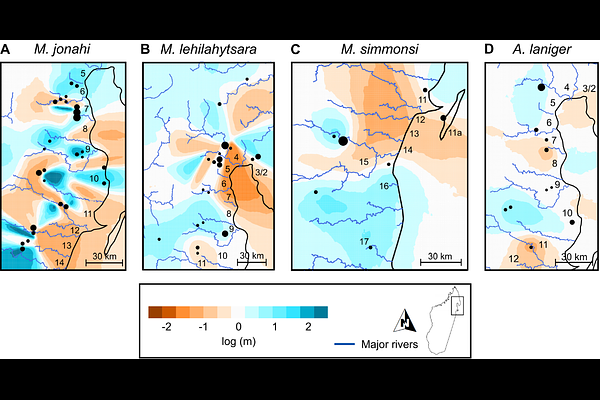Species-specific responses to paleoclimatic changes and landscape barriers drive contrasting phylogeography of co-distributed lemur species in northeastern Madagascar

Species-specific responses to paleoclimatic changes and landscape barriers drive contrasting phylogeography of co-distributed lemur species in northeastern Madagascar
van Elst, T.; Schüssler, D.; Rafamantanantsoa, S. M.; Radriarimanga, T.; Rabemananjara, N. R.; Rasolofoson, D. W.; Randimbiharinirina, R. D.; Hohenlohe, P. A.; Radespiel, U.
AbstractMadagascar is a megadiverse island with exceptionally high levels of endemism, which resulted mainly from allopatric speciation promoted by the island\'s complex physical geography and paleoclimatic cycles. Northeastern Madagascar is uniquely suited to test the relative importance of river barriers, topography and climatic conditions for lemur genetic differentiation. Based on restriction site-associated DNA sequences, we inferred phylogeny, population structure, genetic diversity and rates of gene flow in four mouse lemur (genus Microcebus) and two woolly lemur (genus Avahi) species. In addition, we employed isolation-by-resistance models to test the importance of topography, river barriers, climate and forest cover in restricting intraspecific gene flow. Our results show that significant differences in genetic diversity and connectivity can be explained by varying responses to landscape features and species-specific phylogeographic histories. Rivers present a general barrier to gene flow, and dispersal between inter-river systems is predominantly mediated through high-elevation headwater regions. While this led to high connectivity and genetic diversity in M. lehilahytsara and A. laniger, gene flow among M. jonahi populations is limited by low climatic niche suitability at higher elevations. In addition, topographic complexity promotes connectivity among Microcebus populations, potentially by buffering impacts of seasonal or historic changes in climatic conditions. Finally, the more restricted distributions of M. macarthurii, A. mooreorum and, to some extent, M. simmonsi likely resulted from refugial dynamics and sea level fluctuations which led to geographic isolation, microendemism and secondary contact zones. Our findings generated informed hypotheses regarding the colonization history of the studied species while also having important implications for their conservation.